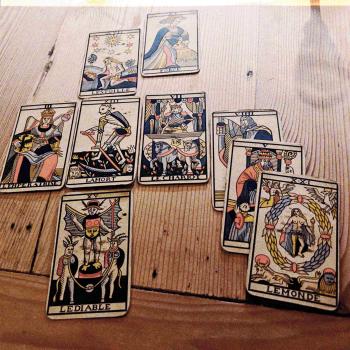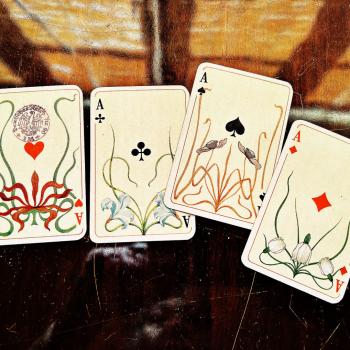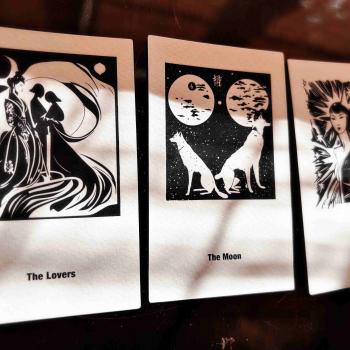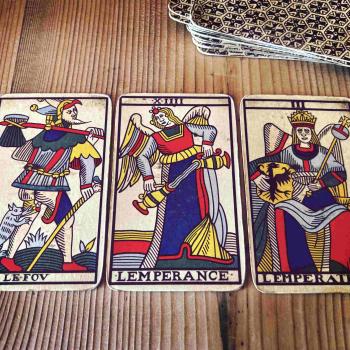Comparisons
Let us compare three situations based on the reading of pretty much the same cards. I use playing cards for this, as they are the classical precursor of all divination with cards, Tarot, fortunetelling, and oracle cards.
For the sake of illustration, and to keep to the bare essentials, there is no question. In real divination situations, I never perform any readings without first anchoring the question in a specific context, but here I want to highlight the premise for why we develop a particular preference for a method or a style of reading.
In line
Consider this string as a narrative first, a case of triage-en-ligne, or the reading that is sentence-based, focussing on what the subject does.
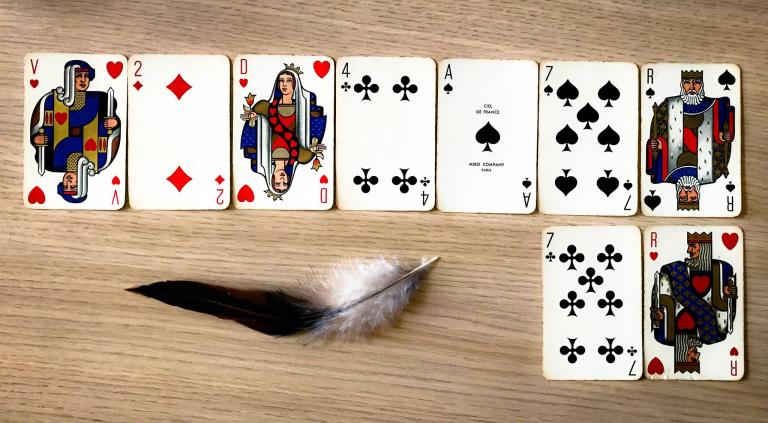
John is meeting Mary in his studio in the basement behind his father’s back.
Variation (with the 7 Clubs and King of Hearts as last two cards):
John is meeting Mary in his studio in the basement with this father’s consent.
Now you’re welcome to say: What kind of bullshit is this?
You’d be perfectly right in calling me out on this bullshit. It is bullshit. It is a completely imagined scenario based on overhearing a conversation between Mary and her best friend, Beth. Beth is worried: ‘What a bastard, John’s father. So where do you meet?’ ‘We meet secretly in the basement’, Mary says, full of apprehension.
Ok, let’s move on to the next scenario in which you now consider how this bullshit contrasts with this other type of reading. This reading is also imaginary, but the style is not. I’ve witnessed this style of reading many times.
Singling out
Here we look at what each card tells us about what the subject is, or what each card is associated with what idea. Most of these associations follow a completely arbitrarily decided upon cartomantic conventions.

The Jack of Hearts means a man of love, openness and generosity. John is a very nice man, loving and caring. Sometimes he may flirt too much with too many people at the same time. But he has a big heart so we forgive him.
The 2 Diamonds means cooperation. Probably involving money transactions.
The Queen of Hearts means a nurturing woman, a woman of love and generosity. She is open and receptive, fertile and kind.
The 4 Clubs means stability at work.
The Ace of Spades means death. It’s bad, or something like that.
The 7 Spades means theft, or magic. Let’s go with magic because we like it better.
The King of Spades means a big, bad magician. We like big, bad magicians. We admire them. Such sheer force. The dark side is so exciting. Ok, the King of Spades can also be a magistrate but that’s more boring. A judge punishing a thief. How boring is that!
So, let’s sum up here: We have John and Mary. They are nice people. There’s something about stability that’s not so good. And that big, bad magician, the King to Spades… What do you think? Bad vibes, no?
It would have been better for John with a benevolent father (KH) who consents (7C) to his amorous encounters (JH, 2D, QH).
End of reading, with a note:
What this narrative string has to do with John and Mary we don’t know, because we focus on individual cards. But if we stretch ourselves a little bit outside of the template that dictates: ‘this card means this thing,’ then maybe we can say that John and Mary have a stable relationship of working together until that gets toppled over by the mean Ace of Spades.
How this impacts on the fact that they both belong to the Heart suit, and that just maybe the working relationship is towards fixing whatever needs fixed with a mean father, we don’t bother to investigate because that would take too much brain work. So, we just say, they have a stable working relationship, and get on with the program. The tall dark stranger ending the string is too good a magic story to ignore. Individually taken.
In layout
Let us now move to the third narrative string, this time in a Celtic cross layout, where we have the cards locked in distinct positions. This type of reading focuses entirely on the subject’s perception and self-perception.
I use 3 extra cards here to fulfil the requirement for a 10-card reading. They are taken at random from the top of the cut deck. The first 7 cards follow the exact same order I drew them in as in the first example.
The Celtic cross layout operates with these positions (see the numbers next to the cards).
1) The Self. 2) What crosses the Self. 3) The Self’s past foundation. 4) The Self’s coping with the past. 5) The Self’s current aspirations. 6) The Self’s future. 7) The Self’s self-image. 8) The Self’s environment. 9) The Self’s hopes and fears. 10) The Self’s deliverance.
Let’s see what we can say here:
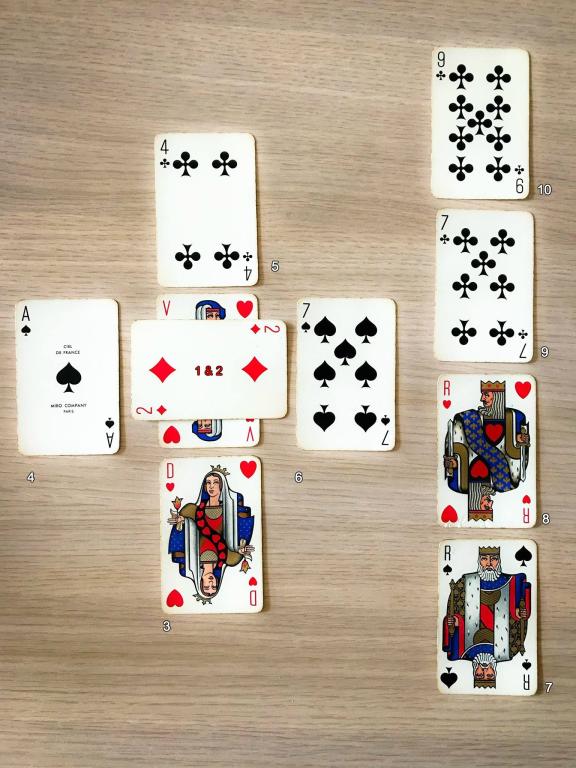
John is at the center of everything, a nice man. He is crossed by cooperation (JH, 2D).
He used to love a woman (QH), but he’s past that anguish now (AS). His goal is to get his shit together (4C) and stop crying (7S).
His Self-image is embroiled with anger (KS), but his father supports him (KH).
He fears he has to work a lot, and hopes for relief (7C), but fate dictates differently (9C), alas.
What’s your preference?
Now, what can we say about these readings, especially if we were to leave out all judgmental positions, declaring loudly which of the outlined narratives carries the most or the least amount of bullshit?
What we can say is this:
The reading in line tells us something about what the subject does, how he acts, thinks, or positions himself vis-à-vis the other actors in the picture. This reading develops a linguistic and sentence-based narrative that gives attention to how self-awareness is constructed and arises in context.
The reading card by card tells us something about arbitrary meanings. There’s no agency here at all. Just meanings. Random meanings expansively oriented towards other random meanings. The dynamic here is of mutual attraction: symbolic meaning attracts symbolic meaning. Nothing gets killed off here in the name of non-substantiality. All symbols are pregnant with meaning by definition.
The reading in layout tells us something about identity-based relations. It’s all about the Self. It’s all about the Self’s worldview, embedded self-image, and internal drama. In the layout, what the Self does, what he’s good at, and how he serves is irrelevant. Layout and positional readings seduce the querent with fancy mirrors.
Here’s my point: Readers of cards read in different ways. Preferences are not subject to critique. One can critique modality and approach, but what’s the point of critiquing preference?
Personally I prefer the method that allows for meaning to arise in context. I also favour the least all identity-centered narratives. But that’s simply because my own spiritual inclinations tilt towards decentering the self through a lot of practice of language deconstruction.
I actually get a major kick out at laughing at language games and at how language ‘thinks’ that just because it belongs to culture it has the upper hand on my thoughts and actions. Even in my dreams I’m aware of just how culturally constructed my thoughts are, and so I never ‘believe’ them. Hence, the reading based on ‘meanings’ doesn’t excite me either, as it takes away the pleasure I have in thinking about permuting with image and word according to what is possible and plausible in any given context.
In my divination practice I aim to deliver statements that make the other I happen to read the cards for think. I’m a fortuneteller that doesn’t tell fortunes. I’m a fortuneteller that deconstructs the hell out of fortunes.
Some like it. Some say, ‘it’s not for me’. Some cross my palm with silver, bowing and retreating with a sense of being high, finding it liberating to go home with the distinct feeling of what it means to trample all over words, words that maintain the illusion of fixed thoughts, thoughts of anger and depression, anxiety or self-elevation, thoughts of desire and denial, thoughts of self that has no substance.
♠
Stay in the loop for cartomantic activities.
If you’re used to getting notifications of new posts from The Cartomancer column, please note that The Cartomancer has moved from Agora to its own individual spot here. You may want to resubscribe, in the top right. Thanks.



